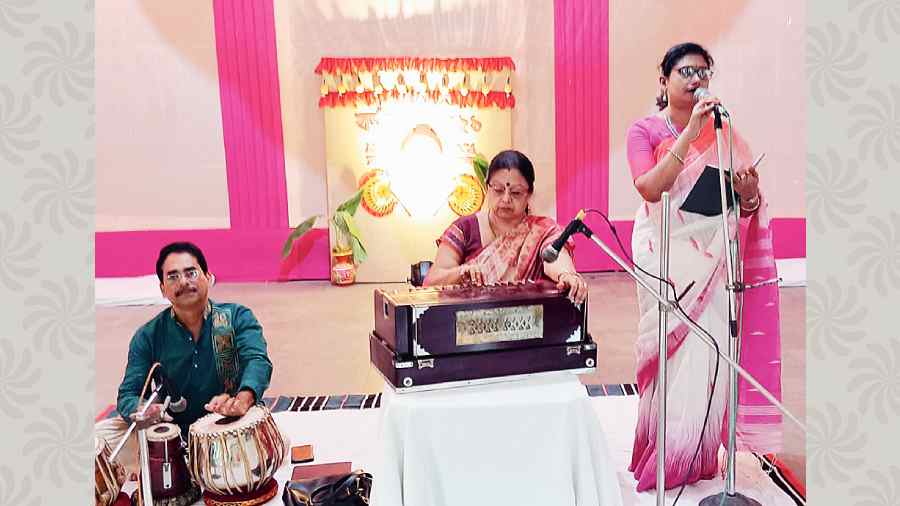BA block
Besides cultural programmes, BA Block Residents Forum ushered in the Bengali New year with a residents’ adda.
Many spoke on the importance of the day itself. “Bengali culture is on the wane and through such events and discussions we can try to involve the younger generation and uphold it,” said block secretary Prasenjit Saha. President Arunava Das seconded him.
Some spoke on haalkhata that is a symbol of tradition on Poila Baisakh. “Back in the day buyers used to pay their dues on a monthly basis and during Nava Varsha they would be greeted with sweets and calendars at shops. But such rituals are fading away now. I can hardly recall being invited to any such shop over the last 30 years in Salt Lake,” said Goutam Sengupta. He also spoke of how Tagore would initiate prayers on the first day of the year in Santiniketan.
Anindya Chatterjee noted how the English new year is now celebrated with more pomp than the Bengali one. “Poila Baisakh reminds many of us of our childhood days when we visited shops holding our fathers’ hands to attend haalkhata and collect packets of sweets. The new generation is missing out on such traditions,” he said.
Many praised the alpona that was painted by block residents on the eve of the new year. “Alpona painting took place for the first time this year on the open ground before the community hall. Residents — young and old — came together for it and it created a beautiful ambience,” said Indrani Ganguly, a former school principal and block resident, who was part of the painting team.
The alpona design was led by resident Jaydeep Gupta and a team of professionals. “In Bangladesh, they draw such alpona on the roads during the Bengali new year. We too wanted to do something different this time after being deprived of festivity for two years,” Gupta said.
There were also some cultural programmes in between the adda, like the customary chorus of Esho hey Baisakh. Sambhabi Ghosh, of Class IV, danced to Fagun Haway haway, Turjo Dasgupta played tabla and there was a group dance to Sohag chand bodoni dhoni. Four-year Chirasman Saha sang Aay tobe sahachori accompanied by his grandmother on the harmonium. “This is his first stage performance,” said his proud mother Nirupama Saha.
There was music by 88-year-old Ashoke Bhattacharya and Sisir Ganguly entertained all by reading out a humourous piece by Rajsekhar Basu on grass.
Bharati Kanjilal
Eastern High
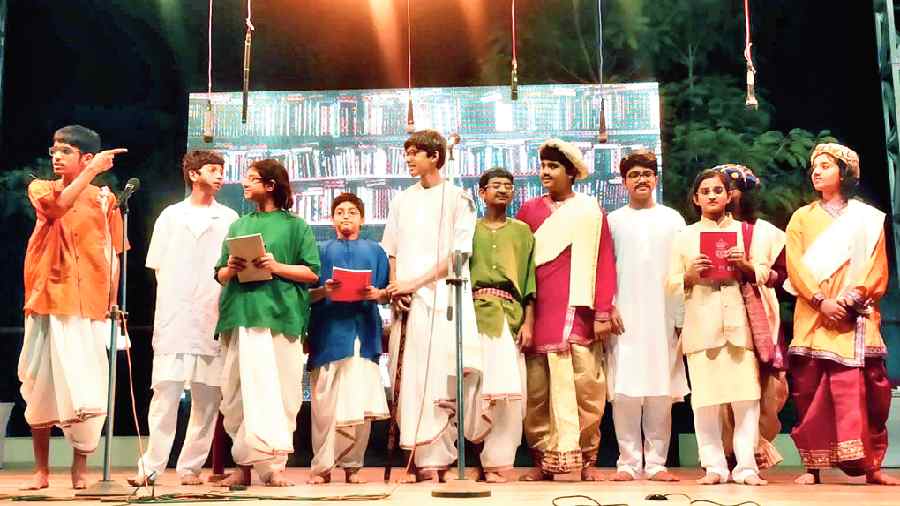
Children stage the play Obak Jolpan at Eastern High in New Town
Residents of Eastern High ushered in Poila Baisakh after a two-year gap with a Tagore-themed function. Rabindranath Tagore was the inspiration behind the simple and elegant decor as also the selection of songs and play.
The programme began with singing in chorus by children, directed by Koel Naha and accompanied with Abirlal Naha, a veteran flautist. “This was an wonderful opportunity for culturally oriented people like us to connect and for the young ones to perform on stage,” Naha said.
The main attraction of the night was the Sukumar Ray play Obak Jolpan, presented by children and directed by Aditi Mukherjee. After a minor hiccup with the sound system that resulted in a false start, the play went off seamlessly and received applause from the audience.
“This year we got to celebrate Poila Baisakh on stage after two years. The zeal came from within and everyone was committed to making it a success,” said Rajashik Kar, one of the organisers.
Kar said that every participant and most residents of the complex had taken the booster dose to prevent the spread of the virus. “I myself was down with Covid in the second wave. But while it has had some side effects, I am fine and it is posing no issues in my playing the flute,” said Naha.
In a bid to stick to tradition, meals were served on banana leaves.
Rushil Sengupta
FE block
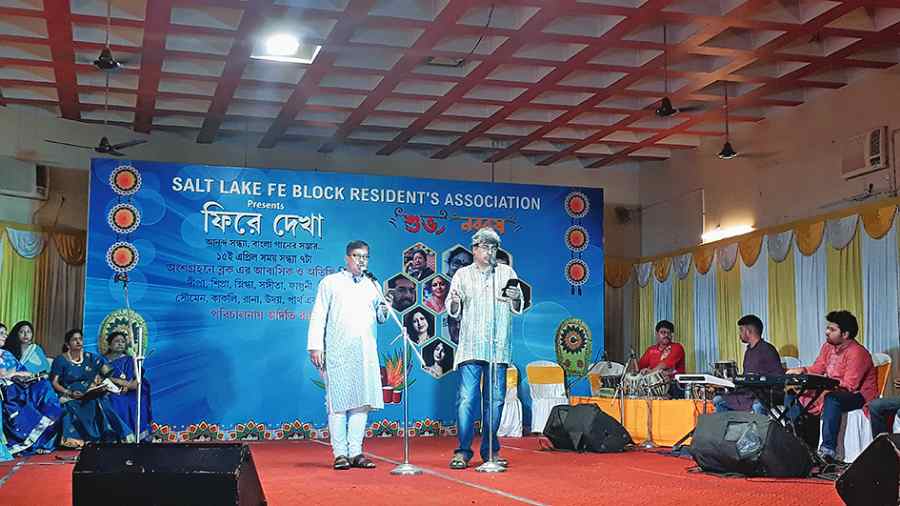
Two residents present a song from the film Deya Neya
About 15 residents of FE Block took stage on Poila Baisakh to present neighbours with a bouquet of songs, accompanied by professional musicians associated with Zee Bangla’s musical shows.The singers had practised with the musicians for over a month to perform songs like Ami bonophul, Akash jure swapno maya, Materia medica kabya and such evergreen melodies were sung. “After being locked in for two years we are trying to resume our normal lives. Such occasions help us come out of our houses and meet our neighbours again,” said Nandita Ghosh, a block resident in the audience.

Residents of FE Block on song
Members of the block’s residents association said they preferred encouraging local talent to inviting singers from outside. “Our block celebrates most festivals and occasions but Poila Baisakh is a relatively new addition. We began celebrating this event only in 2018 but of course, the pandemic created a long gap. We are happy to resume the same this time,” said Kallol Dutta, one of the organisers.
Shatadipa Bhattacharya
Swapno bhor

The runner-up trophy being given to Kestopur resident Atanu Pragyan Banerjee at Swapno Bhor. Picture courtesy Gautam Bhadra
On Sunday, the New Town Boi Mela Samiti organised a debate on whether the Bengali language was losing relevance among Bengalis. Three speakers each lined up on either side for the face-off at Swapno Bhor on a subject that had a heightened emotional ring, being held as it was in the Nava Varsha weekend.
After over an hour of debating, the judges picked two from opposing camps, Soumya Bhattacharya of Patuli and Atanu Pragyan Banerjee of Kestopur, as winner and runner-up respectively, and it was an argument against the motion — that Bengali is not losing relevance — that received the highest approval from the judges.
Expressing confidence in a secure future for the language, Bhattacharya pointed to the spike in the Bengali-speaking populace. “From 2.6 crore Bengalis, among whom just 26 per cent were literate during Independence, we have 9.3 crore Bengalis in West Bengal alone, with a literacy rate of 76 per cent. Their quality of education or language of choice may be questionable, but their quantity is not. Also the despondency about the state of the language is a city issue and not true of rural Bengal.” Rather, Bhattacharya saw the topic through a positive prism. “Even during the time of Nawab Siraj-ud-Daulah, the state language of Bengal was not Bengali but Persian. No other Indian language is a state language other than Bengali, thanks to Bangladesh. So state patronage for Bengali is a new phenomenon.”
Even if there is a temporary setback, the future of Bengali cannot be anything but bright as the Bengali population on both sides of the border totals 25 crore, he summed up.
Banerjee, a software engineer, lacked that optimism as he spoke of the state of the language in his immediate surroundings. “Of course, one can argue for a language being a river in flow to which anything that is added will be swept along. But the prevalence of Hindi or English terms in ungainly fashion jars on the ear,” he said, citing usages like ‘keno ki’ (from Hindi kyun ki). He traced the root of the problem to the lack of financial capital in the hands of Bengalis and the pliability of Bengalis as a community. “Both factors together explain why dubbed versions of a Kannada film like KGF Chapter 2 or a Telugu-Tamil production like Baahubali mounted on a lavish scale does roaring business in Bengal while a Bengali film like Jatiswar fails to do business in other parts of the country.”
Youngsters of the earlier generation were taught in the Bengali medium and had no choice but to read Bengali story books. “Our children get educated in English medium and they have access to story books in English that are glossier in production and more suited to their experiences. For example, where is a Durjoy Datta to appeal to young minds in Bengali? Our stories in the vernacular are rather back-dated,” he argued.
Among the judges, Anup Matilal, former curator of Rabindra Tirtha, provided the final word. “Bengali has seen wax and wane in terms of the importance accorded to it. Even in the 19th century, when English was the language of administration, Ishwarchandra Vidyasagar had already modernised the language and there was a renaissance with the best and brightest using the language. At the same time, we had pidgin usage like in the call of New Market shop-owners to attract European buyers: Take take take, no take, no take, ekbar to see. So the current trend is not new,” he said.
At the end of the debate, the house voted by a show of hands, refusing to accept that Bengali was under threat.
The cover of the Baisakh edition of a magazine published by Slet Pencil, a collective of authors, was also inaugurated at the programme.
Sudeshna Banerjee
Action Area 1 community centre
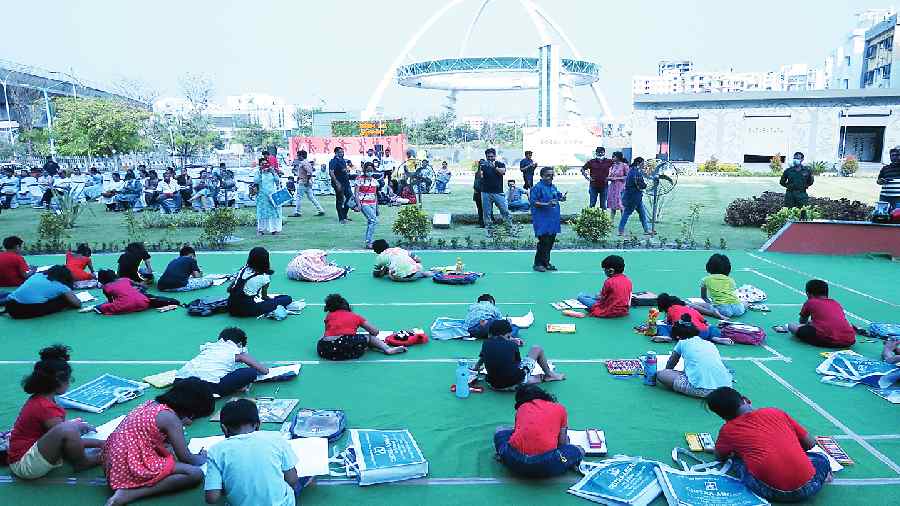
Children take part in a sit-and-draw contest for New Town residents on Sunday. Sudeshna Banerjee
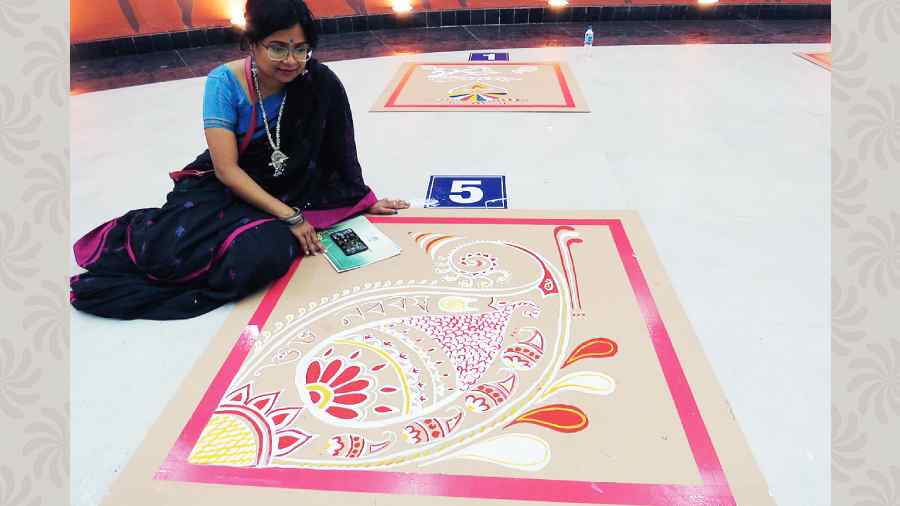

The winning alpona. Sudeshna Banerjee
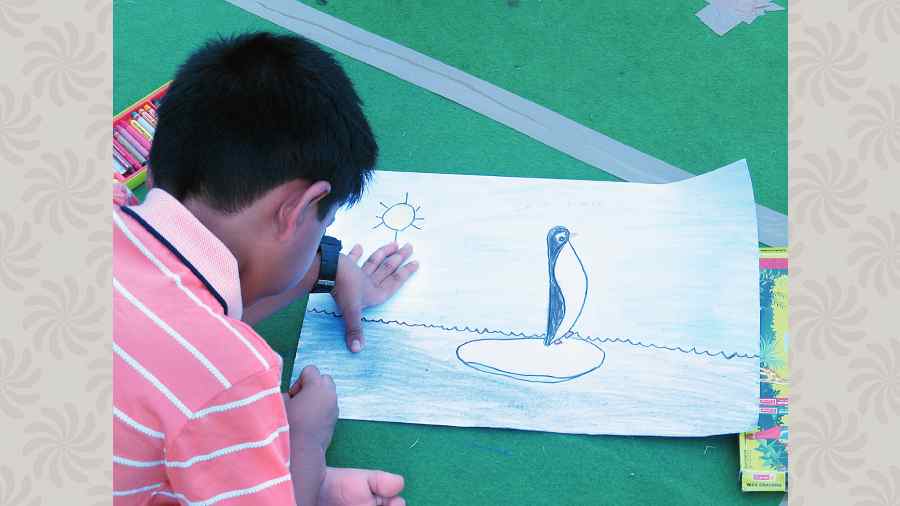
Swapnil Das, 5, paints a penguin.
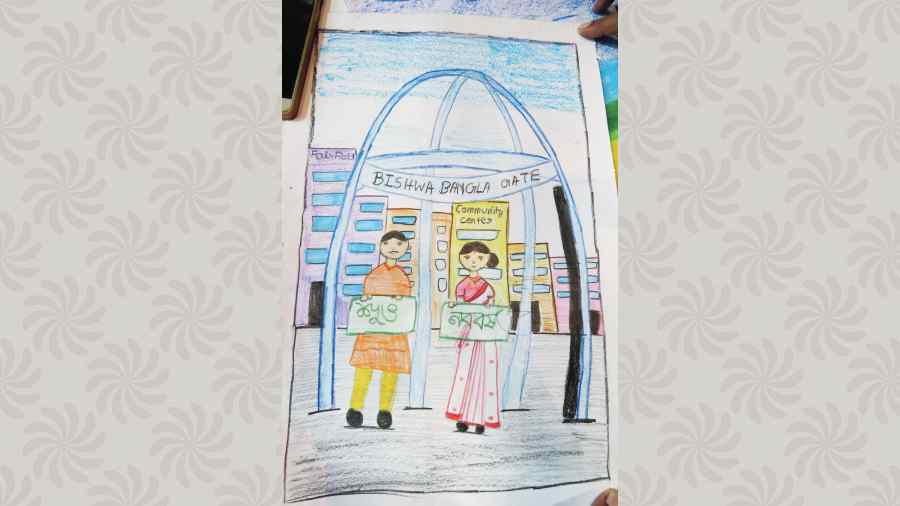
A winning entry in the drawing contest. Pictures by Sudeshna Banerjee
Nonagenarians Bani and Santosh Kumar Ganguly being felicitated at CK-CL community hall. (Right) Supriya Sengupta performs. (Brinda Sarkar)The Action Area 1 community centre welcomed residents of New Town at its first community programme organised by the Newtown Kolkata Development Corporation (NKDA) since the building was inaugurated last November.
“We want to familiarise residents with the building since it is meant for their use. So we thought of holding a programme to welcome the Bengali new year,” said NKDA chief executive officer Animesh Bhattacharya at the event.
From 3pm, the lawn was abuzz with children settling down on the mat for a sit-and-draw contest and their parents. The participants were divided into three age groups. While the tots could draw anything, the other two were given “Nava Varsha in New Town” and “Festivals” as themes.
Many of the parents got anxious and kept shouting out instructions at their wards. Judge Ashok Mullick had a tough time making them move away.
But when little Saanvi Bhattacharya was seen breaking into copious tears as she was unable to draw a watermelon, it helped to have mother Chaitali Chakraborty around. “She loves the bright colours of the watermelon and had planned to draw one,” the Action Area II B resident said, as she encouraged the four-year-old to discard the earlier attempt and try afresh.
Manya Deka’s canvas was a riot of colours, with the six-year-old from Akankha creating parallel bands with her pastels, leaving the judge to wonder whether she had anything planned as subject. She did sketch an outline of a tree on top of it all, which won her the second prize in her group. Swapnil Das let his imagination take wing and drew a penguin under a bright sun. The five-year old from BA Block came third. Samanvita Sarkar, 5, aced the group with her entry of a swan in a pond.
The participants in the older age groups were a serious lot but none more so than Samriddhi Roy. The 10-year-old from DD Block had no time to answer questions as she drew shoppers at shops celebrating Poila Baisakh. The effort earned her the second prize in her age group, in which Asmita Biswas, 9, came first and Suprabha Saha, 9, came third.
All three winners in the senior group — Ankita Saha, Samprit Saha and Sukla Mondal — were 13-year-olds. Two depicted Durga puja and another Holi.
There was also an alpona-drawing contest in the ground floor hall. BA Block neighbours Sucharita Das and Mallika Sarkar won the contest with their traditional motif. “We had taken our kids to the sit-and-draw competition when we were urged to sign up. This prize is a bonus,” laughed Sucharita, a school teacher who had worked as a volunteer during the second wave, attending distress calls on the New Town Covid helpline.
The second prize went to Jayanti Nandi and Meghna Kundu. The third, drawn by the doctor couple Sayantan Ghosh and Arunima Haldar, had a modern touch with New Town monuments like Biswa Bangla Gate woven into the design. “There is Metro Rail and Happy Pod in our alpona as well,” said the eye specialist, who left soon after completing the alpona to see a patient and returned to receive the prize.
Winners of the Durga puja dhunuchi dance contest held at Visarjan Ghat and contests on Radio Newtown were also felicitated. “There were 10 of us from Greenwood Sonata. Every year, we win. This is the first time we came second,” said Paramita Adhikari, runner-up trophy in hand. Greenwood Park won among the housing complexes.
Among the blocks, the winner was ALAKAI, the association formed of three blocks in Action Area 1. “There were four of us as there was a cap on the number of participants. Nor was our dhaki to be allowed. So it was with a YouTube recording of dhak beats that we practised for two days. Since we have a sense of rhythm it was not a problem to dance with dhakis provided by NKDA,” recalled Tia Roy of AL Block.
Sudeshna Banerjee

Nonagenarians Bani and Santosh Kumar Ganguly being felicitated at CK-CL community hall.

Supriya Sengupta performs
CK-CL Block ushered in the New Year with cultural programmes and blessings from residents aged 90 and above.
“We have at least six residents above the age of 90 in the twin blocks,” said Monalisa Sengupta, a member of the block committee who was the emcee of the show. “I made umpteen calls around the block to trace these elders over several months. Most of them are too weak to come to the community hall for their felicitation so we went over to their homes and presented them tokens.”
The only ones to make it on the day were Santosh Kumar Ganguly— who at 97 is the senior-most resident of the block — and his wife Bani Ganguly, 91. A past president of the block, Santosh Ganguly spoke at length to the audience about the early days of the neighbourhood.
“We moved into Salt Lake in 1984 when there were barely any other houses in the block or street lights or even streets. There were just acres of kash forests. I remember my wife Bani knocking on the doors of any house that came up, trying to form a ladies’ club,” said Santosh Ganguly. “Over the years every block in Salt Lake has formed its own association but CK and CL have remained united. I wish the present association all the best in looking after the best interest of residents here.”
Bani Ganguly read out a self-composed ode to the bygone year. “I stepped out of the house after many years today,” she smiled.
Besides this segment, the event saw lots of performances by residents. There were recitations by those like five-year-old Animikh Roy, for whom this was his first ever stage performance, as well as Tanmay Chattopadhyay, a senior citizen, who was performing after many years. “I never got a chance to recite much after school so was a little nervous. My wife was in the audience and I didn’t want to embarrass her in front of her friends!” he laughed.
“Esho hey baisakh,” sang Ruby Chatterjee, Sutapa Bhattacharya, Srabanti Ghosh and Papiya Dasgupta, who egged on the audience to sing along with them. Everyone did so happily. Dipen Bose, an 85-year-old resident of CL Block, enlivened the show with his upbeat rendition of Ami chey chey dekhi shara din and then on public demand also Humein tumse pyar kitna. “I’ve never learnt music but have a huge stock of songs committed to memory,” he smiled. “I’m so happy with this get-together. We all needed a break from the rigmarole of life.”
There was a colourful dance by Madhurima Bhattacharjee and Mousumi Dutta and a collage of poetry combining the new year, women’s empowerment and Tagore by Sonali Sen and her recitation students.
“I am a management student and have recently moved into CK Block as a paying guest. I am trained in Bharatnatyam and love dancing so much that I actually went around looking for the block committee members to ask if I could perform on Poila Baisakh,” laughed Supriya Sengupta. Her equally enthusiastic roommate Susmita Manna also performed to Mor bhabonare.
Brinda Sarkar
